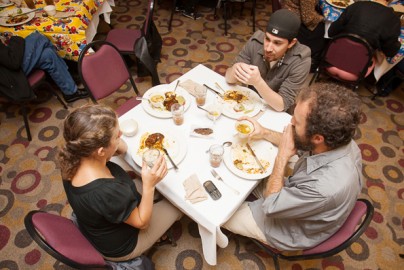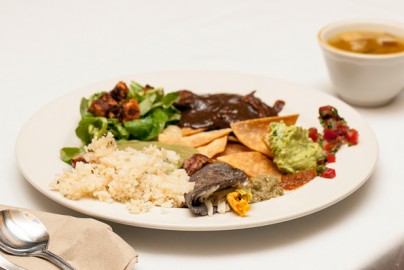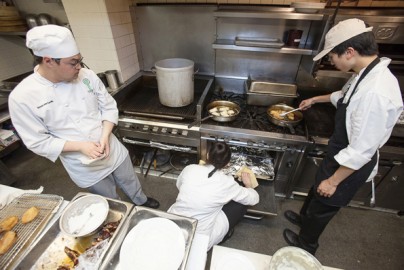Local gourmets discover Oaxaca

Tortilla chips, guacamole, molé negro—a popular Oaxacan sauce made with chocolate—and quesadillas filled with squash, flower blossoms and locally harvested cheese comprised the $40 all-you-can-eat dinner that students prepared from scratch.
All the proceeds will fund scholarships for next year’s three-week-long summer abroad program, called “A Taste of Oaxaca,” which costs $2,600 per student. The dinner is in its third year. This year’s grocery expense to the culinary arts program was $350.
Most students in the renowned program, which supplies restaurateurs with competitively-trained chefs, benefit from the pool of scholarship money.

“I call it ‘paying it forward,’” Head Chef Mark Hodgson said with a smile. “[Students] invite their friends and family and share their experiences with them.”
Many of the dishes showcased techniques the students learned while in Oaxaca, Mexico.
A slideshow featured students foraging for mushrooms on mountains 10,000 ft. above sea level. They cooked with Oaxacan chefs and watched the city’s daily parades. Students were seen working alongside Oaxacans clad in aprons with embroidered trim.
“It was really eye opening being able to cook the Oaxacan food and expand my palette,” said culinary student Nicholas Yee, 20.
Food is the heart and soul of Oaxaca, the culinary capital of Mexico. Hodgson, a Latin American studies major from UC Berkeley, visited the city three years ago and immediately wanted students to go too. The food of Oaxaca has since become a staple in the 3-unit Ethnic Cuisines course for Culinary Arts and Hospitality Services students and culinary professionals.
“It’s great to be able to share with the students lots of special things going on in Oaxaca,” Hodgson said. He enjoys the indigenous culture, the food, parades and celebration.
Student chef Cristobal Alvarez, 23, spent this summer’s semester abroad in Oaxaca and carries the memories with him.
“I remember thinking, I could completely relocate here,” said Alvarez, whose family is from Mexico. “The culture is so rich, it gave me a sense of pride to be there learning about my indigenous culture.”
Students worked with indigenous Oaxacans who have been cooking most of their life and regularly prepare meals for city events. The students worked anywhere from four to eight hours a day learning how to make octopus salad and a variety of molés and breads.
“The food is so rich in spices,” said student chef Chrissy Hua, 26. “There was one cooking day completely devoted to habanero.”

According to a 2010 study INEGI, Mexico’s census group, more than a quarter of Oaxacans do not make an income and nearly half make less than double the minimum wage. They even cook bugs, a rich source of protein.
“They have such a rustic approach to cooking,” Alvarez said. “They use handmade clay pots and rolling pins made out of stone.”
With the success of their trip to Oaxaca and new recipes in tow, City College’s culinary students are enlightened.
“It was eye opening on so many different levels,” said student chef Sydney Dow, 21. “We are so fortunate here in the U.S.”
Follow Hawkins on Twitter: @DannieDoll

Comments are closed.